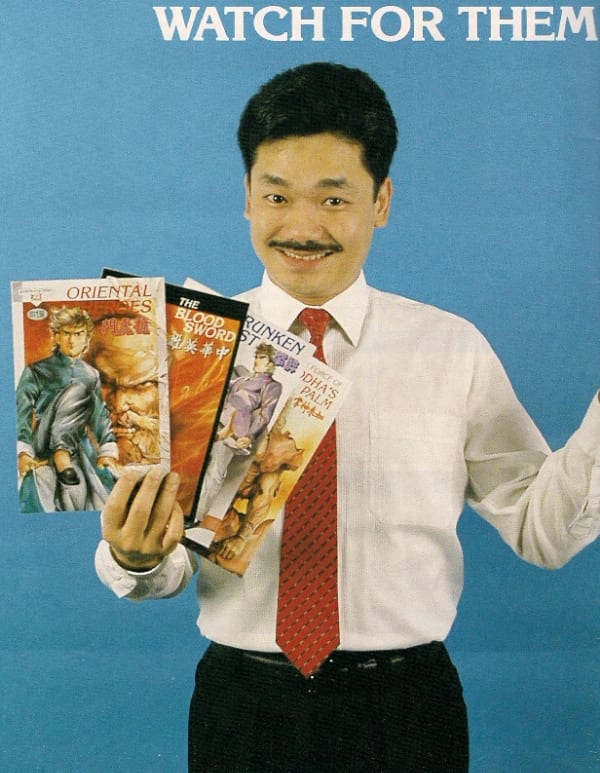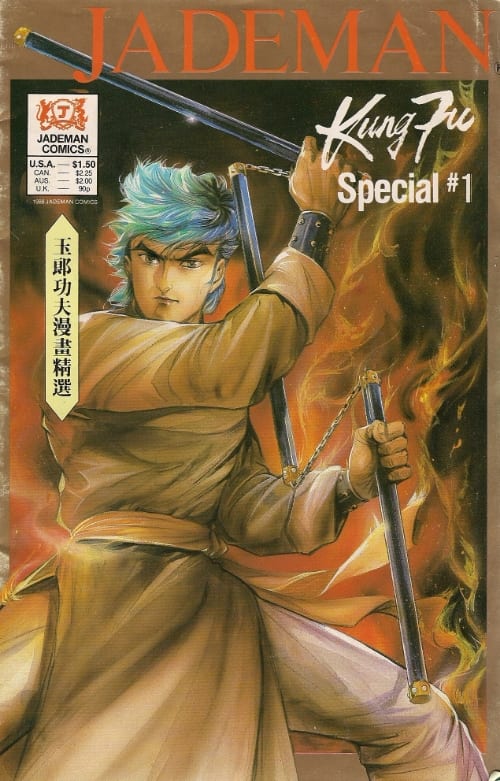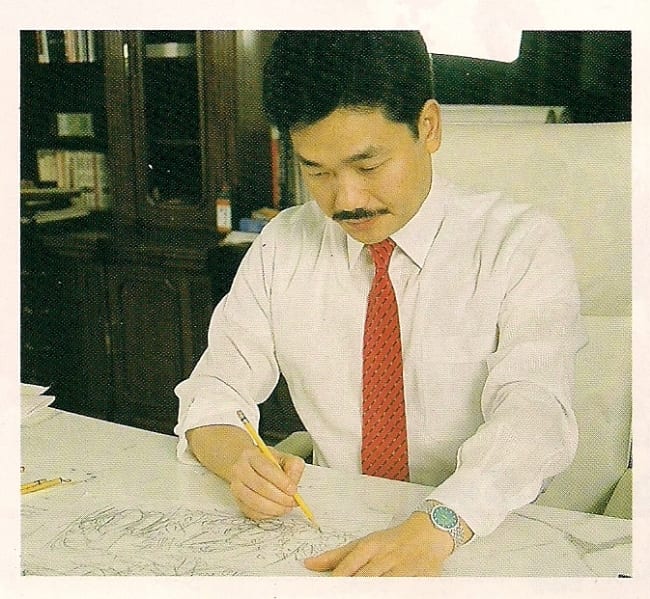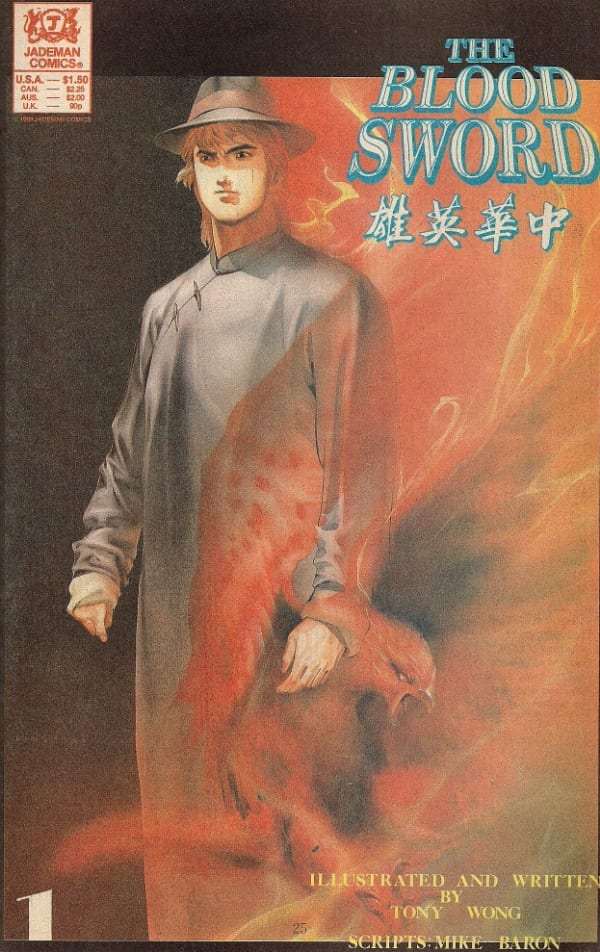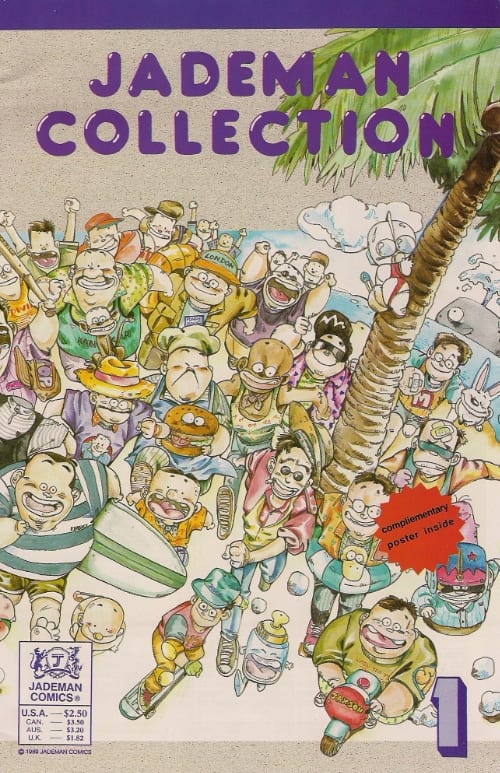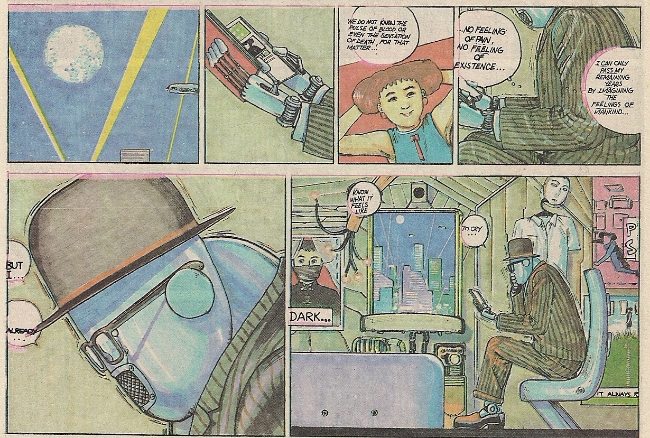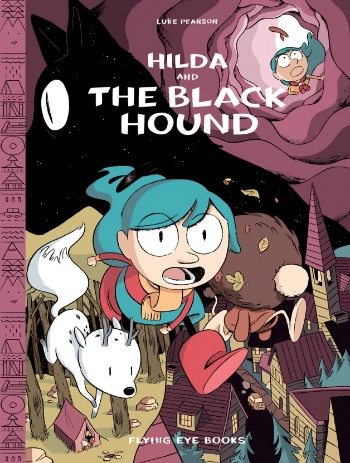I've written about this before, but not in detail. From 1988 to 1993, the monolithic Hong Kong comics publishing entity Jademan (Holdings) Limited, which once claimed to control 80% of its domestic comics market, released 300 individual publications to North American comic book stores. Many of them were 64 pages in length, to account for the huge amount of translatable material at hand; it was by far the largest English translation effort undertaken for manhua at that time, and the thousands upon thousands of resultant pages of art still command fascination from back-issue specialists and Asian comics aficionados.
But where there is fascination, there is also intimidation.
"Joe, where do I start with Jademan?!" It's a question I've encountered innumerable times, often by the water cooler or while shopping, or in the act of making love. But because I am incapable of effective communication, except in cases where my words are appended to a comic book shopping list, I've had no answer until today. Here, finally, is a brief guide to potential touring points in this nation of comics.
--
1. Jademan Kung Fu Special #1
In many cases, it makes sense to start at the beginning. No month was given for this, Jademan's first-ever North American publication, but the year was definitely 1988, the price was $1.50, and the mission was total immersion: nearly all of these 64 pages consist of extensive, breathless previews for Jademan's four martial arts-themed launch serials: Oriental Heroes (which ultimately ran to 55 issues in total), The Blood Sword (53 issues), Drunken Fist (54 issues) and The Force of Buddha's Palm (55 issues), all of them re-scripted in English by the American writer Mike Baron. All in all, the book serves as a detailed guide to why you might be interested in the convulsing, breakneck plots of series which, for the most part, would be starting up somewhere well into their lengthy HK runs for the purposes of sparing you less modern-looking pages.
That's not the reason you want this, however.
Wong Yuk Long -- hereafter referred to by his preferred English sobriquet, "Tony" Wong -- is the founder, publisher and top artist of Jademan. I did not need to tell you this, because if there is any lesson you take from this comic whatsoever, it's that Tony Wong is one of the great men of modern Hong Kong, that his wealth and influence are virtually limitless, and that "the Walt Disney of the East" has verily arrived to bring his unerring aptitude for success to the heartland of America.
It may have been that this was a necessary illusion. As the Jademan literature gaily indicates, the company, in 1986, had gone public on the Hong Kong Stock Exchange. What was left to add by academics, like Wendy Siuyi Wong in her 2002 book Hong Kong Comics: A History of Manhua, was that the "Black Monday" crash of October, 1987, had left Jademan financially wounded. Was its North American expansion simply ill-timed in this regard, or was it the desperate flailing of a company watching itself slowly bleed out, hoping for a fresh source of income?
Regardless, a brave face was necessary. Tony Wong's face.
SEE: TONY WONG AT THE DRAWING BOARD IN A SHIRT AND TIE!
WITNESS: TONY WONG POSING WITH A FANCY RED CAR!
GASP: AS TONY WONG CREDITS HIMSELF WITH OTHER PEOPLE'S WORK!
He is a showman, this Tony Wong - a real Stan Lee, though I would argue that he is more interesting than the American model. For starters, Wong actually *could* draw; he built his career on infamous action comics of the late '60s and early '70s, unforgettable images blending manga-inspired squat cartoon figures with garish, extremely bloody violence. These were the kind of comics which inspired legislation to control them, though the experience only educated Wong on the value of controlling the means of production. Like Charlton in America, Jademan came to own the very presses which put out its books.
Moreover, Wong had become enamored with the studio system; in an interview with Giant Robot, Wong noted his early admiration for Golgo 13 creator Takao Saitō, whom readers of this website will recognize as one of the innovators of extreme delegation in Japanese comics, relying upon a veritable army of assistants to accomplish specified tasks on the assembly line of prodigious comics production.
Of the four Jademan launch serials, three of them (i.e. everything *not* The Blood Sword) really were created by Tony Wong. Oriental Heroes was basically the same action series Wong had been running since the ultra-violent days of 1970. But as the Jademan Kung Fu Special admits to a certain extent, you can't draw all of this stuff yourself. Probably, Wong wasn't drawing anything in some of these comics, all photographic indications to the contrary. The boots-on-the-ground would remain anonymous, sacrificed, perhaps, in the name of a celebrity's appeal in times of trial.
--
2. Jademan Collection
Eventually, Jademan branched out into newer series. Blood Sword Dynasty (41 issues) arrived in 1989, and a newer-on-all-fronts project, Iron Marshal (32 issues), dropped in 1990. Iron Marshal was the product of a younger artist, Khoo Fuk Lung, who left the series mid-stream and was replaced by Lee Chi Ching; the former artist would later helm a short-lived Image series, Solar Lord (1999), while the latter would find some success in Japan, winning the first-ever International Manga Award in 2007. Jademan was excited by these projects - a pair of oversized illustration collections were even made available through mail order, the Iron Marshal Graphic Art Album (1 issue) and the Blood Sword Graphic Art Album (1 issue), which remain the rarest (read: most expensive) Jademan items.
So, if my math is correct, that brings us to a total of 293 publications dedicated to people kicking each other in the head or the promotion thereof.
But Jademan didn't *just* publish martial arts serials in Hong Kong - there were humor comics, romance comics, horror comics. And, insane as it might have been, the decision was made in 1989 to bundle samples of all the rest of this stuff into (again) 64-page packages under the banner of Jademan Collection (3 issues). Scripted in English by Len Wein, these comics offer a rare glimpse into stores set mostly in contemporary Hong Kong, or fantasy environments unlike the exotic combat zones showcased in the 'main' series.
They're also severely fucking weird.
Tony Wong had a comics-format alter ego: "Jademan Wong." I can't imagine the personality of this character remained constant throughout the years, but his portrait in the Jademan Collection shows a cocksure salt-of-the-earth bisexual who's irresistible to men and women alike. This is rude humor -- in case the racial caricatures on the cover above hadn't tipped you off -- honing in on any deviation from traditional societal roles for comedy firepower, with Tony Wong at the center. In one vignette he's disguised as a woman to participate in a female mud wrestling match atop a gigantic pile of shit; the referee checks him for foreign objects, and fondles his junk before extracting a fat stack of bills from the crotch area. At another point he's dressed as Disney's Snow White, getting into kung fu battles with the huntsman and forcing the prince (also played by Jademan Wong) to kiss him for years on end, to no avail. What onanism!
It's difficult to tell who the prospective audience was for all this. The art above is by Wong Kwok Hing, a humor comics specialist who worked on Yuk Long Manhua Biweekly, a magazine basically dedicated to shoring up Tony Wong's ties with the wider HK entertainment industry in the '80s. Perhaps this is from where some of these stories were taken: 'mainstream' comedy, dropped mostly unaltered into a foreign land with no context. You can see why I'm recommending this rare glimpse!
Other stories present the breadth of possibilities. Hong Kong manhua has never been as diverse as Japanese manga, but it did have its experimenters, prominent among them Li Chi Tak, about whom I've written before. Here we see the young artist in the 1980s, flaunting two mighty poles of world comics influence: Katsuhiro Ōtomo and Métal Hurlant.
Then there's guys like Hui King Sum, about whom I cannot find a single word in English - unless he's the same Hui King Sum who put together a Resident Evil Code: Veronica miniseries at WildStorm back in '02. I mean, he *could* be; once you hook up with a studio for licensed work your visual style is probably gonna shift to best accomplish the task, but those comics didn't look anything like this, a splendid Otomo/Akira Toriyama cartoon approach with a great faculty for speed and motion. Interestingly, Hui does two stories in Jademan Collection: one is a romantic comedy, while the other is a bleak thriller about a man whose time-travel escapades cannot prevent the rape of his wife and his own murder at the hand of a home invader.
Another cultural note: there is a LOT of sexual violence in Jademan comics, at least compared to American genre comics. Sometimes this takes on unique forms:
This is the final page of a completely baffling comedy-horror story by Taipo Tsui, about whom I known absolutely nothing. The woman at the bottom of the page is sick and tired of her boring husband, and embarks on an adventure with a mystery stalker. We are led to believe that the trenchcoated man is actually the woman's husband, attempting to surprise her, but the twist on this romantic cliché is that the husband winds up going down for sexual assault, while his wife leaves with a genuine sexual predator. Yet aside from the pungent moralism of this parable, what resonates is the artist's utterly berserk mess of visual cues - note the Batman cameo in panel 5! Characters devolve into wobbly doodles when upset, only for an obligatory HK airbrush-painted panel to capture distressingly real emotion. It's rough, near-amateur level comics, which makes it disquieting; a more polished presentation would shove things firmly in the direction of comedy or horror, while this straddles the line in an uncanny fashion.
Jademan Collection did not last. A fourth issue may have been planned, but in late 1990 we got a miniseries instead, Jademan Opens the Gates of the Night (4 issues), which presented squarebound packages of b&w horror comics, now apparently translated in-house, with stilted diction and loose, semi-professional lettering. Absolutely nobody is credited for anything, save for the editor, Alan Wan. But then, per a contemporaneous in-house credit listing from other titles, the Jademan overseas production team consisted of ten people in 1990, half of which were literally teenagers.
Also absent was Tony Wong. He was forced out of the troubled company; you can estimate the time, because his name is suddenly scrubbed from all new titles. By 1991, he would be in jail for forgery.
Yet Jademan continued, for a while, without its founder, his creations continuing without him. It sounds so perverted and wrong, when put that way, but isn't it standard procedure for the American superhero giants, and the American legacy newspaper strips? Truly, this company seemed more familiar than ever before.
--
3. The Blood Sword & Blood Sword Dynasty
Note the corrected credit on this, the official first cover.
Ma Wing Shing is not well-known in English-speaking terrains, but in Hong Kong he is a figure not unlike the superhero artist Jim Lee: a rock star talent who defined his era so thoroughly that his tics and his tricks thereafter became the criterion by which 'good' genre art would be judged by mass devotees. Like Tony Wong before him, Ma sought Japanese inspiration, this time from the work of heavyweight seinen artists like Ryōichi Ikegami. Indeed, it could be said that the smash success of Ma's work with Jademan prompted Tony Wong's own studio serials to shift their style to respond to him.
If there is any 'long' Jademan serial to start with, I would recommend Ma's, but not just because he was (and, like Lee, remains) a popular artist - so confident was Jademan in Ma's appeal, that unlike the various Tony Wong serials, which all began in media res, often far from their origins, The Blood Sword actually starts at the beginning, in 1980, in quite a rough place. I think the earliest of these episodes appeared in the Golden Bo, a daily newspaper, and it's rough, populist fare, seeing a fresh-faced hero and his blood-hungry blade wreaking vengeance on rapist whites (scriptwriter Baron breaks out "foreign devils" on page one, panel one, issue one) and fleeing to faraway lands, encountering troubles and exploitation, but also allies.
Better yet, unlike the Wong serials, which maintain a very fixed look by virtue of heavy studio direction toward a house style, throughout The Blood Sword you can witness Ma's personal evolution as a stylist from this:
to this:
Bodies become heavier, the folds of fabric more luxurious, the use of text more judicious, and the sharpness of the individual strikes more confident - everything seems pointy and painful, a sense of violence which accrues over pages and pages. There are few details of Ma's working methods in English, but my understanding is that he functions in much the manner of a typical weekly manga artist, which is to say that unlike Tony Wong or Takao Saitō he keeps his hands on the page, even as he necessarily directs assistants to perform whatever functions he cannot personally do under threat of deadline. And weekly serialization creates a lot of pages - so many that Jademan invented Blood Sword Dynasty as a means of getting newer storylines into print; it's not a spinoff, just later work from the same, massive series.
Like many other things Jademan, it was a bit of a lie.
--
In 1989, Ma Wing Shing broke away from the ailing Jademan to form his own publisher, Jonesky. He had reportedly been told this by a fortune teller: "A gold fish will always be confined to the pond. But when it meets cloud and wind, it will become a dragon." There are not many great soothsaying anecdotes in world comics, but this is one of them. The Blood Sword was continued with other artists, while Ma's own material appeared in English basically without his participation, but by then the artist was at the helm of Storm Riders, a multimedia franchise he's supposedly begun wrapping up only now, one quarter of a century later.
In 1993, around the time Jademan finally called it a day in North America, Tony Wong was released from prison. He wrote a book about the experience, Tiger in the Cage (tragically unavailable in English), and formed a new company, Jade Dynasty. He'd apparently lost the rights to all of his old creations, which are still held today by Culturecom Holdings Limited, which either acquired the old Jademan some time in the '90s or actually *is* Jademan under a new name - the corporate literature makes it very difficult to tell.
Through Jade Dynasty, Wong continued to pursue the English-language market, via Image (Mega Dragon and Tiger, 5 issues, 1999), Dark Horse (Ultraman Tiga, 10 issues, 2003-04) and even DC (Batman: Hong Kong, OGN, 2003). But manga had revolutionized the consumption of Asian comics in English by that point, and it was through two companies -- ComicsOne and its successor, DrMaster -- that Wong released the majority of his studio's works to North America as bookshelf-ready tomes in the '00s: Mega Dragon and Tiger (again), Weapons of the Gods, The Legendary Couple, Four Constables.
And Storm Riders. And other Ma Wing Shing studio titles, which the publisher(s) also pursued. There were even eight collected books of The Blood Sword, no doubt via agreement with Culturecom, under the new title Chinese Hero, with new translations and shiny modern colors. For a little while it seemed the old band had gotten back together, though like many reunion acts, you could be forgiven for imagining the front men hanging prudently to opposite ends of the stage. The golden age was over. Jademan would not return.
***
PLEASE NOTE: What follows is not a series of capsule reviews but an annotated selection of items listed by Diamond Comic Distributors for release to comic book retailers in North America on the particular Wednesday identified in the column title above. Be aware that some of these comics may be published by Fantagraphics Books, the entity which also administers the posting of this column. Not every listed item will necessarily arrive at every comic book retailer, in that some items may be delayed and ordered quantities will vary. I have in all likelihood not read any of the comics listed below, in that they are not yet released as of the writing of this column, nor will I necessarily read or purchase every item identified; THIS WEEK IN COMICS! reflects only what I find to be potentially interesting.
***
SPOTLIGHT PICKS!
Twelve Gems: Being a 248-page Fantagraphics release from Lane Milburn, another of the busy young artists once associated with Closed Caption Comics. Indeed, the artist notes that some characters from this book first appeared in 2010's CCC9 anthology, although this is surely a much grander stage. One of several contemporary comics projects informed by Heavy Metal and '80s action manga, the scenario sees a trio of action folks, humanoid and animal, on a quest for gems of power. The spirit of Dalgoda lives in our hearts forever! Preview; $19.99.
Hilda and the Troll (&) Hilda and the Midnight Giant (&) Hilda and the Bird Parade (&) Hilda and the Black Hound: I'm not gonna guarantee this stuff will actually show up anywhere - I mean, I don't guarantee that for anything in this column, but here a little more warning is necessary since Diamond isn't even listing them for release, even though the major east coast retailer Midtown Comics insists they're coming in. It's a quartet of popular kid-appropriate 8 1/2" x 11 3/4" hardcover color comic albums by Luke Pearson, ranging in length from 40 to 64 pages, all published by the UK outfit Nobrow. Hilda and the Black Hound is new this year, I believe, and may be a decent place to start. Samples 'n review at Forbidden Planet; $24.00 (each), save for Hilda and the Troll, which is $18.95.
--
PLUS!
DKW: Ditko Kirby Wood: I wish there was an alarm I could sound whenever Fantagraphics puts out a new comic book-type comic - although I guess this column is sort of a braying horn anyway. So - here is Sergio Ponchione, creator of the Ignatz series Grotesque and unseen in North America since Mome ended, whipping out a 32-page tribute to the American masters in the title, with one segment dedicated to embodying the style of each artist. There's gonna be three hundred thousand copies of Rocket Raccoon #1 out in the wild this week, but imagine yourself reading this; $4.99.
Rocket Raccoon #1: Yeah, that's right - I said 300,000 copies of Rocket Raccoon #1, although apparently 1/3 of them are going out through some deal Marvel cut with a geek culture-type service where they send you a box of items for a monthly subscription fee. Nonetheless, that's a lot of copies, and it's but one of several series Marvel is launching this week in support of the Guardians of the Galaxy movie opening next month. That said, it's also something of an auteur project for writer/artist Skottie Young, a lively stylist who might make this especially worth a flp. Preview; $3.99.
Cosplayers #2: Tezukon: FANTAGRAPHICS - YOUR SOURCE FOR COMIC BOOKS. I did not know Dash Shaw was planning to make a series of this, but here is another 32-page account of two girls dressing up and telling lies, this time set at a big anime con. "During the convention they face off against a Street Fighter 2 Cammy, encounter two otaku boys who are obsessed with their youtube videos, and meet a manga scholar named Ben Baxter, who sleeps in a dumpster outside of the hotel and receives visions of the ending of Tezuka's unfinished 'Phoenix' saga." This sounds great; $5.00.
Black Kiss XXXmas In July Special: There is definitely a parallel reality where Fanta is publishing this as well, but in our world the burden rests on the shoulders of Image. I liked Black Kiss 2 - it was gnarly as hell, yet shot through with a grotesque sort of allegorical autobiography that roused vulnerability too. This one-off reprisal promises "an endless stream of incredibly nasty revenge sex," provided it actually shows up at your local shop, which is not a guarantee if you reside outside of the United States, given what happened last time. Chaykin also has Satellite Sam #9 out this week, in collaboration with writer Matt Fraction. Preview; $5.99.
Cinder and Ashe: Jesus, where the hell did this come from? Straight out the mouth of the '80s Suggested for Mature Readers mainstream, I guess, as Gerry Conway & José Luis García-López author this New Orleans-set post-Vietnam PI suspense thing, which DC is reissuing as a collected book for reasons unknown beyond the fact that it's never, to my knowledge, been reprinted before; $14.99.
Library of American Comics Essentials Vol. 5: The Bungle Family, 1930: Fuck yeah, nothing like a lil' Harry J. Tuthill to get the spirits soaring. I love these squat little books from IDW, which reprint a selected year's worth of a new strip every time - they're great samplers, yet they 'sample' to the extent that you really get the feeling of following these features, with one strip doled out per 11.5" x 4.25" page. This one should make for a solid shot of sophisticated domestic comedy, a quintessential acquired taste; $24.99.
Robocop vs. The Terminator - Gallery Edition: Get ready to lean this up against IDW's The Mighty Thor Artist's Edition and make them kiss, because Dark Horse is now bringing a 15" x 17" color-printed b&w original art edition of Walter Simonson's 1992 collaboration with Frank Miller, an antic spread of violence that adopts a considerably lighter tone than even the satiric Robocop franchise had seen before. Bonus pencils, promotional materials and a Simonson foreword are also promised. Note that the publisher is also releasing "restored" color edition of the original in hardcover this week; $125.00.
Wonton Soup Omnibus: Much smaller -- yet still larger than its manga-sized original printing(s) -- is this 6" x 9" Oni compendium of James Stokoe's 2007-09 space trucker series, a b&w project that's probably faded a bit in prominence under the luminosity of the artist's newer color affairs like Orc Stain or Godzilla: The Half Century War. Now you can see for yourself. Big sample; $19.99.
The Love and Rockets Library Vol. 10: Luba and Her Family: Finally, here is Fantagraphics again with the fourth from the Gilbert Hernandez wing of the 7.5" x 9.25" softcover Love and Rockets library, now collecting 228 pages of stories from beyond the original Palomar saga. Worth experiencing in any form. Samples; $18.99.


